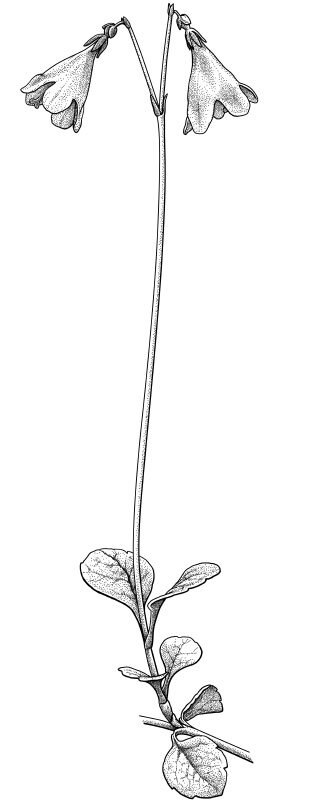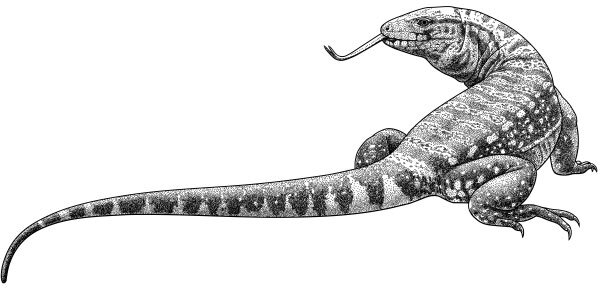[Virtual Exhibition] Charles Darwin's Barnacle: Emily S. Damstra & Stephen Heard
Scientific illustration walks the line between art and science. This year, UNB Biology Professor Stephen Heard published Charles Darwin’s Barnacle and David Bowie’s Spider. To bring the organisms in his book to life, he worked with illustrator Emily S. Damstra of Guelph, Ontario.
This virtual exhibition features Emily’s artwork from the book along with enlightening excerpts from Stephen’s research on the origin of species names, touching on the history of science as well as inclusivity. After viewing the exhibition, find interesting musings from the artist & writer on cross-disciplinary collaboration and the connections between art and science by visiting here.
Charles Darwin’s barnacle, Regioscalpellum darwini
More than 300 species are named for Charles Darwin: plants, insects, worms, algae, mushrooms, sponges, frogs, birds, and even a dinosaur. The honour paid to Darwin is completely appropriate: his 1859 book On the Origin of Species by Means of Natural Selection is the most important scientific work ever written. The Origin explains both the similarity of all life on Earth (via its single evolutionary origin) and its diversity (via natural selection and evolutionary change).
But Darwin wrote many other books – among them, works on coral reefs, worms, orchids, carnivorous plants, and barnacles. He published his barnacle books before The Origin, and they went a long way in establishing his reputation as a biologist. They also consumed eight years of his life in painstaking work, and once led Darwin to remark “I hate a barnacle as no man ever did before”.
Twinflower, Linnaea borealis
Twinflower, Linnaea borealis, is a small forest-floor herb common in northern conifer forests. Its delicate pink flowers, poking just a few inches above the ground, are a beautiful treat for those willing to see the forest from their hands and knees.
The name Linnaea commemorates Carl Linnaeus, the 18th-century Swedish botanist who invented our modern system of Latin (scientific) naming. It was Linnaeus’s favourite plant, and he was the first to use the name Linnaea in print. Although Linnaeus credited the Dutch botanist Jan Gronovius with coining the name, Gronovius had nothing to do with it. Instead, Linnaeus named Linnaea after himself – which is allowed, but considered by scientists to be in poor taste. Among the millions of Latin names that have been coined, only a handful of other self-namings are known.
Sorting-hat spider, Eriovixia gryffindori
For centuries, scientists have named species after characters from fiction. Linnaeus named hundreds of species after figures from Greek mythology; and there are species named for characters from Charles Dickens, Victor Hugo, Herman Melville, JRR Tolkien, Terry Pratchett, and many more. Do scientists read Harry Potter? Consider the sorting-hat spider, Eriovixia gryffindori. It’s named for Godric Gryffindor, the original owner of the magical hat that sorts Hogwarts students into houses. This spider was named by Javed Ahmed and collaborators, who explained that the “uniquely shaped spider derives its name from the fabulous…sorting hat, owned by the…medieval wizard Godric Gryffindor…stemming from the powerful imagination of Ms. J. K. Rowling, wordsmith extraordinaire. An ode from the authors, for magic lost, and found.” (Ahmed et al. 2016 Journal of Arachnology 5:24)
Madame Berthe’s mouse-lemur, Microcebus berthae
Madame Berthe’s mouse-lemur, Microcebus berthae, is the smallest living primate. One would fit easily in your hand. Only about 8,000 individuals survive in Madagascar’s tropical dry forests.
The species’ name honours Dr. Berthe Rakotosamimanana – or “Madame Berthe”, as her students and colleagues called her. Madame Berthe was born in 1938 and was educated in Madagascar and France before returning home to teach primatology at the Université d’Antananarivo.
Madame Berthe taught thousands of Malagasy students. She was also a linchpin for scientific research in Madagascar – training Malagasy researchers and arranging for foreign researchers to visit and work with their Malagasy colleagues. If Microcebus berthae survives (its habitat is under threat), it will be thanks to Madame Berthe and the legion of scientists and conservation workers who are her legacy.
Eastern St. Paul’s wort, Sigesbeckia orientalis
Carl Linnaeus named Sigesbeckia for the Prussian botanist Johann Siegesbeck – but he didn’t mean to honour him. Instead, Linnaeus named the weedy and unattractive plant as an insult, because the two botanists had squabbled over the merits, and the morality, of Linnaeus’s system for classifying plants based on their sexual parts. Scientists have very occasionally yielded to temptation, naming a species to insult someone they despise. Sometimes the insulted party hits back: consider Elsa Warburg’s naming of the trilobite Isbergia parvula (“deficient”) for Orvar Isberg, and Isberg’s retaliation with the mussels Warburgia crassa (“fat”) and Warburgia iniqua (“unjust”). We shouldn’t admire this, but we can be amused.
Mabel Alexander’s hoverfly, Cepa margarita
Mabel “Margarita” Alexander (1894-1979) was the spouse of Charles Alexander, and together the Alexanders described and named over 11,000 new species of craneflies. But what does “together” mean? Mabel’s name doesn’t appear on most of the published papers. There’s a long and sorry history of male scientists being supported by uncredited women. There may be more to Mabel’s story than that, though. Even though she had no scientific training, Charles often expressed his belief that they were scientific partners, and late in their careers Mabel began to get formal credit as coauthor. One of Charles Alexander’s PhD students named Cepa margarita in Mabel’s honour; another species is Cepa alexander, and Mabel and Charles are united forever in that genus of flies, as they were over a long career in science.
Andean emerald, Amazilia franciae
The Andean Emerald, Amazilia franciae, is a hummingbird native to forest edges in the Andes of Colombia and Ecuador. It was named in 1846 by Jules Bourcier, for his daughter Francia. It’s one of a number of birds named by ornithologists for their daughters and wives (Bourcier also named the Emerald-Bellied Puffleg, Ornismya alinae for his wife Aline). A more recent trend in namings for husbands is a welcome sign that science has become more open to participation by all genders. As an example, the goblin spider Grymeus dharmapriyai, named in 2018, is a valentine from Sasanka Ranasinghe for her husband Prasanna Dharmapriya – a spider, yes, but one sporting a prettily decorated and heart-shaped body plate.
Stan Vlasimsky’s weevil, Eupholus vlasimskii
Sometimes, scientists use species names to raise money for research or for conservation. Stan Vlasimsky paid $4,000 to have this dramatically patterned weevil named for him – and he paid similarly to have an orchid named for his wife, and a butterfly, a lizard, and two frogs named for his four children. These are part of a larger program, BIOPAT, run by a consortium of German research institutes that has raised almost a million dollars this way. Some scientists are horrified by the notion of selling names; others are enthusiastic about a chance to raise sorely-needed research and conservation money while also raising the profile of species discovery.
David Bowie’s spider, Heteropoda davidbowie
Over David Bowie’s 50-year-long musical career, he reinvented himself constantly; but fans will remember his early-1970s alter ego Ziggy Stardust. Bowie-as-Ziggy roamed the stage thin, long-legged, and orange-haired, and was backed by his band, “The Spiders From Mars”. Heteropoda davidbowie is a spider (although from Malaysia, not Mars), and like Ziggy it’s thin, long-legged, and orange-haired. Among celebrity musicians with species in their honour: Lady Gaga (a fern and a planthopper), Beyoncé (a horsefly), all four Beatles (trilobites), Mark Knopfler (a dinosaur), and Jerry Garcia (a roach, of course). There’s no reason that naming species can’t be fun.
Isabella Abbott’s red alga, Iziella abbottiae
The practice of scientific naming evolved in Europe, and sadly, those honoured in scientific names are overwhelmingly white, Western men. The neglect of other groups is most dramatic with respect to Indigenous people. There are species named for Indigenous peoples (like the leafcutter bee Hoplitis shoshone), and species named for Indigenous warriors, emperors, and the like (the butterfly Parides montezuma). What’s lacking: names for Indigenous individuals, honoured for their contributions to science. Partly, Indigenous people have been excluded from science; and partly, they’ve been neglected in naming. The alga Iziella abbottiae is a refreshing counterpoint, named for the first Indigenous Hawai’ian woman to earn a PhD in science. She was an authority on red algae and wrote extensively about Hawai’ian traditional knowledge of marine biology. Many more Isabella Abbotts are out there, waiting for science to include them and tap their potential.
African coelacanth, Latimeria chalumnae
On December 22, 1938, a young museum curator in East London, South Africa got a phone call. Would she like to pick through a haul of fish brought into port by the trawler Nerine? Marjorie Courtney-Latimer headed to the docks, and there discovered a 5-foot, blue-and-silver fish like nothing she’d ever seen before. She preserved it, working frantically without access to much equipment, and the specimen shook the scientific world. That’s because it proved to be a coelacanth, a living member of a fish family known only from fossils and thought to have been extinct for 65 million years. J.L.B. Smith, the ichthyologist who identified and named the specimen, refused Latimer’s suggestion that it be named for the trawler’s captain. “Scientific workers have cause to be grateful”, he wrote, “and the name Latimeria stands as my tribute.”
Southern magnolia, Magnolia grandiflora
Few people realize that the name “Magnolia” refers to a person; but it honours Pierre Magnol, a 17th century French botanist who made important strides in understanding plant relationships. His work, although he didn’t know it, was a big step toward the realization that all life on Earth has a common evolutionary origin. But Magnol spent much of his life outside French scientific institutions, because he was a Huguenot: a Protestant in Catholic France, subjected to official and unofficial discrimination. How many brilliant scientists are still sidelined by xenophobia and intolerance? Every spring, when the magnolias blossom and promise that summer is coming, their name might also promise hope for a more inclusive future.
Spruce’s bristle-moss, Orthotrichum sprucei
Richard Spruce (1817-1893) was a British botanist who spent 15 years on an epic series of voyages around the Amazon and the Andes. He documented the harvest of rubber, collected plants with new and unexpected medicinal properties, and played a critical role in getting Cinchona trees into cultivation outside Ecuador.
Cinchona bark contains quinine, a powerful antimalarial drug, but the tree was overexploited and was becoming rare in the wild. Spruce’s Cinchona collections saved hundreds of thousands of lives over the next century. But medicinal plants weren’t Spruce’s passion. When he was sick, or injured, or had been robbed – all of which happened repeatedly during his expeditions – he wrote that he could “forget…all [his] troubles in the contemplation of a simple moss”. Spruce’s bristle-moss was named in 1845, so Spruce knew that sometimes, someone lost in “the contemplation of a simple moss” would be contemplating one named for him.
Argentine giant tegu, Salvator merianae
This lizard’s name honours Maria Sibylla Merian (1647-1717), a brilliant naturalist far ahead of her time. Merian’s family were publishers, and as a child she collected flowers and insects to be illustrated. In 1679, she published an important book on caterpillars, linking egg to caterpillar to butterfly at a time when many scientists still believed caterpillars were spontaneously generated from dew. In 1699, Merian sailed to Suriname so she could observe and paint insects in the tropical rain forest. She was the first European to report on what lived in the rain forest canopy, in her masterwork, Metamorphosis Insectorum Surinamensium. After she died, her work was revered, then criticized, then forgotten – and in the 1970s, rediscovered. The Argentine giant tegu appeared in one of her Suriname paintings, which showed her appreciation of ecological food webs – long before ecology was a science.
Gary Larson’s louse, Strigiphilus garylarsoni
Some people have beautiful orchids named after them, or majestic soaring birds of prey, or graceful antelopes. Gary Larson got a louse.
Gary Larson is the cartoonist behind The Far Side, which often made weird but insightful jokes about scientists and nature. Biologists in particular loved The Far Side, and one biologist thanked Larson by naming Strigiphilus garylarsoni – a louse that infests an African owl – for him. Larson’s reaction: “I considered this an extreme honor. Besides, I knew no one was going to write and ask to name a new species of swan after me. You have to grab these opportunities when they come along.” Gary Larson: prizewinning cartoonist, and all-around good sport.
If you enjoyed the virtual exhibition above, click here to expand your mind with a conversation between Stephen & Emily about the nature of art and science, including beautiful bonus illustrations.
If you loved these illustrations, see Emily S. Damstra’s wonderful portfolio by visiting her website here.
If you can’t get enough of Stephen Heard’s tales of scientific naming, find his book Charles Darwin’s Barnacle and David Bowie’s Spider here and his humorously insightful blog, Scientist Sees Squirrel, here.
For more exciting stories on the intersection of nature and art, get CreatedHere’s Issue 12: Enviro here.















